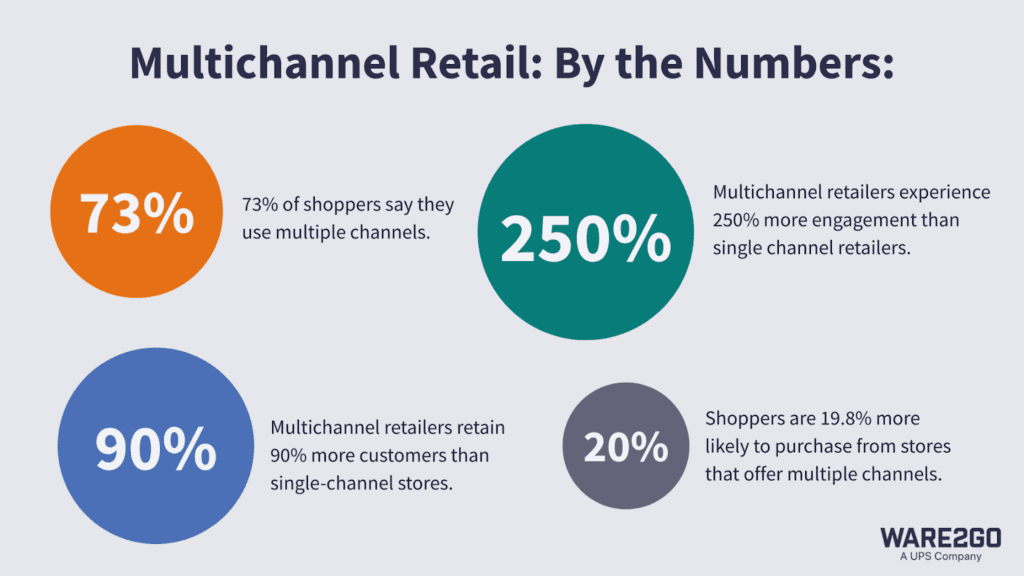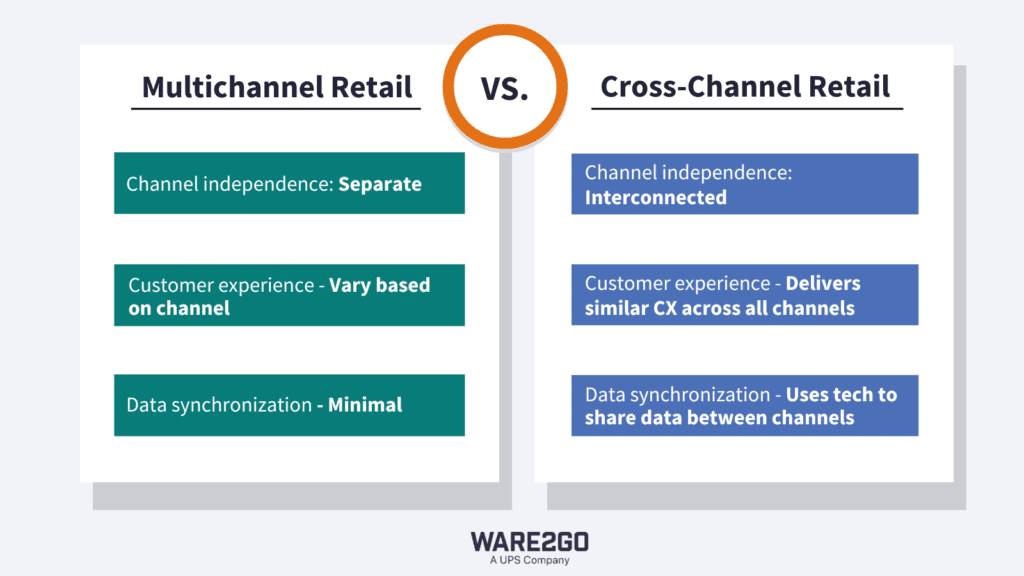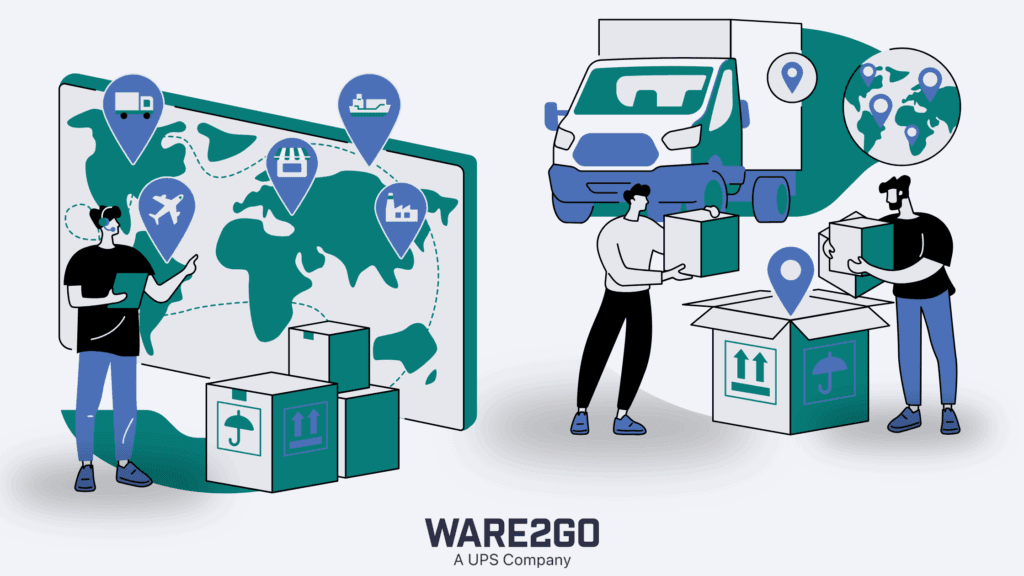Most online retailers are too reliant on a single channel, and it’s costing them.
Today’s shoppers don’t care where they buy — they care how fast the item ships, how easy it is to return, and how consistent the brand experience feels across every touchpoint.
Shoppers jump from Instagram to Amazon to your website and back again before ever clicking “Buy.” You’re invisible if you’re not showing up consistently across those touchpoints. Worse, your competitors are showing up — and they’re scooping up the sales, the data, and the loyalty that could’ve been yours.
Sticking to one or two sales channels might feel simpler, but it exposes you. One algorithm change, one warehouse delay, or one channel policy update can crush your margins overnight.
That’s why more brands are turning to multichannel retail, which allows them to expand into new platforms without sacrificing control over their operations or customer experiences.
In this guide, we’ll explain how multichannel retail works, how it differs from omnichannel and cross-channel strategies, and how to scale across platforms without losing efficiency, accuracy, or sanity.
What is Multichannel Retail?
Multichannel retailing means selling on multiple offline and online sales channels simultaneously to meet modern customer expectations. While the final purchase may happen in one place, numerous touchpoints facilitate the buying decision.

Consumer shopping behavior today is inherently multichannel; a recent study revealed that 73% of shoppers use multiple channels during their journey.
While brick-and-mortar still dominates in the US — making up nearly 84% of retail sales in 2024 — eCommerce is steadily gaining ground and is projected to grow to 20% by 2028.
Retailers who adapt to an increasingly multichannel retail landscape stand to benefit. Data shows that those using three or more channels see 250% higher consumer engagement than single-channel sellers. This multichannel engagement also drives a 9% increase in average sales revenue.
Offering multiple options for how and where customers receive their orders also impacts conversion. Shoppers are 19.8% more likely to purchase from retailers that offer multichannel pickup services like curbside delivery.
Once they convert, they’re also more likely to stick around: retailers with multichannel strategies retain 90% more customers than those relying on a single channel.
The Evolution of Multichannel Retail
With the rapid growth of eCommerce, multichannel retail has evolved exponentially in recent years.
Big retailers like Walmart have expanded their online presence and, to grow their eCommerce catalogue, are adding more and more third-party sellers. In fact, Walmart Marketplace is adding an estimated 5,000 new third-party sellers each month.
This dramatically changes the eCommerce ecosystem, making Walmart Marketplace the second most important marketplace for merchants, after Amazon.
Not only have some of the major players become more aggressive in carving out their share of the market, but more new and independent marketplaces have arrived on the scene. This has been particularly evident since the shift to a digital-first economy ushered in by 2020 shutdowns.
However, brick-and-mortar retail is still an important component of a multichannel strategy. With ‘Buy Online Pickup In Store’ (BOPIS) fulfillment options and in-store returns, a presence on the shelves of retail stores is a major leg-up for SMBs.
What Types Of Channels Should You Add To Your Multichannel Strategy?
Though the internet may have changed the way we shop, multichannel retailing has been around for centuries. In fact, retail giant Sears started out as a mail-order business in the late 1800s before opening stores across the country.

Below are the most common retail channels seen today:
Brick-and-Mortar Stores
For decades, physical locations have been the primary distribution channel, giving sellers the unique ability to connect with potential customers face-to-face. Now, retail juggernauts like Walmart use their vast brick-and-mortar footprint as indirect fulfillment centers to get goods to consumers faster and for less.
Beyond traditional retail chains, brands are rethinking how physical stores fit into their multichannel strategy:
- Flagship and Pop-Up Stores: These formats allow DTC brands to test physical retail without long-term commitments. Pop-ups are especially useful for seasonal sales or product launches, while flagship stores help build brand identity and customer loyalty in key markets.
- Retail Chains: Partnering with established retailers like Target, Walmart, or Best Buy opens doors to new customer segments and leverages the retailer’s nationwide distribution capabilities. This is an ideal path for wholesale growth and vendor relationships.
- Showrooms: Brands like Warby Parker and Bonobos use showrooms to merge the best of in-person and digital shopping. Customers try on or demo products in-store, then complete their purchase online, creating a seamless multichannel experience.
Consumer Direct eCommerce
Direct-to-consumer (D2C) allows shops of all sizes to sell products straight to consumers without relying on wholesalers or third-party retailers. All that is required to start selling is a website or mobile app.
A range of D2C platforms make it easy for merchants to launch, manage, and scale their online stores, such as:
- Shopify: A user-friendly platform ideal for fast-growing brands looking to scale quickly.
- BigCommerce: Offers built-in features for omnichannel selling and robust performance.
- WooCommerce: A flexible, open-source option for businesses already using WordPress.
- Magento (Adobe Commerce): Best suited for enterprise-level customization and complex product catalogs.
Social Media Platforms
Social media has evolved from a product research and paid advertising platform to another sales channel. Buying from select brands on social media platforms like Instagram, Facebook, and Pinterest without leaving the app has become commonplace.
Popular social commerce platforms include:
- Instagram and Facebook Shops: Integrated checkout and shoppable posts streamline discovery to purchase
- TikTok Shop: Combines viral content with seamless in-app purchases
- Pinterest Shopping: Turns product inspiration into real-time buying decisions
- YouTube Shopping: Enables creators to tag and sell products directly in video content
By 2025, social sales are projected to account for nearly 20% of all online sales, making it a channel retailers can’t ignore.
Online Marketplaces
Led by Amazon, eCommerce marketplaces like eBay, Etsy, Rakuten, and Walmart Marketplace act as single, centralized buying centers, mostly selling goods from third-party vendors.
Like the convenience afforded by traditional big-box stores, online marketplaces offer a wide selection and inexpensive shipping options. Consequently, the reach and scale of these eCommerce giants have forced shops to adapt and play by their rules.
Each marketplace has its own strengths, depending on your brand, product category, and fulfillment strategy:
- Amazon: The dominant marketplace with massive traffic and FBA integration
- eBay: Great for resale, refurbished goods, and collectibles
- Walmart Marketplace: Offers exposure alongside a trusted retail brand
- Etsy: Ideal for handmade, vintage, and niche products
- Target Plus: Curated platform for select third-party sellers with a premium feel
B2B and Wholesale Platforms
For retailers targeting bulk orders and business customers, wholesale platforms are a valuable addition to a multichannel retail strategy.
Notable wholesale retail options include:
- Faire: A curated platform that connects independent brands with thousands of retailers.
- Alibaba: A global B2B marketplace ideal for manufacturers and international sourcing.
- Handshake: Shopify’s wholesale platform was built to help D2C brands expand into B2B sales without leaving their existing ecosystem.
These platforms simplify the buying process for B2B transactions by offering streamlined ordering, tiered pricing, and access to large-scale buyers.
Catalogs
While the internet has made mail-order catalogs rarer, direct mail is still far from dead. According to Harvard Business Review, Patagonia, Crate and Barrel, and Nordstrom are just a few retailers investing heavily in catalogs.
Moreover, pure-online retailers like Wayfair and Birchbox include catalogs in their strategy, taking advantage of the lower competition for mailboxes than email inboxes.
What’s the Difference Between Multichannel Retail and Cross-Channel Retail?
Both multichannel and cross-channel retail involve selling across multiple platforms. The difference, however, lies in how those channels work together.
- Multichannel model: Each platform runs independently with separate systems and limited coordination. While sales occur across separate channels, fulfillment is often fragmented, with different teams or providers handling logistics for each channel, making optimizing costs and delivery speed harder.
- Cross-channel retail: Uses integrated technology to connect channels, creating a unified view of inventory, fulfillment, and customer experience. This allows businesses to consolidate operations, streamline fulfillment, and gain better control over delivery performance across every touchpoint.

To better understand the distinction, it helps to look at how each approach adapts across three key areas: channel independence, customer experience, and data synchronization.
Channel Independence
In a multichannel setup, each sales channel operates independently. Inventory, marketing, and fulfillment may be handled separately, often by different teams or platforms.
Cross-channel retail connects these touchpoints. Channels are integrated through a shared backend, enabling better coordination and oversight across the business.
Customer Experience
Because multichannel systems run independently, customer experience can vary from one channel to the next. Promotions, shipping options, and even return policies might differ based on where the customer shops.
The goal of a cross-channel approach is consistency. Shoppers receive the same experience (messaging, service, and branding) regardless of their chosen channel.
Data Synchronization
Multichannel strategies often lack real-time data sharing between platforms. That can result in stockouts, fulfillment delays, and incomplete customer insights.
Cross-channel retailers use technology to sync inventory, customer data, and order tracking across systems. This gives them a single source of truth and more efficient operations.
As brands become more comfortable with multichannel selling, the next evolution is integration — first through cross-channel coordination, and ultimately through a fully omnichannel experience.
What’s the Difference Between Omnichannel Retail and Multichannel Retail?
If cross-channel retail connects the dots, omnichannel retail builds the full picture. It takes integration further by delivering a seamless, personalized customer experience across every online and offline touchpoint.
While multichannel retail is often used interchangeably with omnichannel retail, they differ in several ways:
- Product vs Customer Focus: Multichannel focuses on selling several products across different sales channels, whereas omnichannel focuses on the customer across numerous channels.
- Channel Coordination: While a multichannel approach tends to feature siloed channels, omnichannel retail is fully integrated using a single tech stack.
- Customer Experience: Multichannel customer experiences vary based on channel. Omnichannel delivers seamless shopping experiences across all channels.
- Data integration: With multichannel retail, data and inventory synchronization is minimal. An omnichannel setup, however, involves real-time data flow between different channels.
- Personalization: Although multichannel retailers can personalize each channel, omnichannel retailers can create a unique buying experience using unified customer data.
The product is the focal point in multichannel retail, with each channel providing an independent purchase opportunity. While this approach expands reach, it often results in a fragmented user experience.
By contrast, omnichannel retail puts the customer at the center, and the impact of this unified approach is considerable:
- Omnichannel consumers now account for 27% of all retail sales and deliver a 30% higher lifetime return on investment than those using a single channel.
- In fact, companies that embrace omnichannel engagement strategies see, on average, a 179% boost in sales revenue over those that don’t.
That said, multichannel retail is the essential first step for many businesses, offering immediate reach, flexibility, and growth potential across various platforms.
What Are the Advantages Of Multichannel Retail?
Adopting a multichannel retail strategy offers significant advantages to growing brands. From quick market entry and broader customer reach to greater resilience and data-driven insights, sellers can scale successfully and serve customers wherever they are.
Here are some of the benefits of multichannel selling:
1) Low Entry Point
Businesses can get up and running quickly, establishing new revenue streams across multiple digital channels without the overhead of a physical store. Products can be exposed to thousands of first-time buyers in new online marketplaces or geographies without significant upfront investment.
2) Larger Audience
More channels mean more chances to connect. With multichannel retail, customers can quickly scan online reviews and social media posts to learn about others’ purchase experiences. This social influence, built on rave reviews and positive testimonials, is a powerful way for retailers to attract new customers.
3) Increase Resilience
Selling across multiple channels diversifies risk in the event of an account suspension, supply chain breakdown, or algorithm update. With a multichannel strategy, sellers aren’t reliant on a single platform that could change its rules anytime and hurt sales. Plus, stores have more control over brand equity and promotional material like customized packaging.
4) Customer Data
Multichannel retail offers more opportunities to gather information about customers. Using data from online marketplaces and third-party retailers, sellers can reduce cart abandonment rates, retarget individual customers more effectively, and optimize the user experience on each platform.
What are the Disadvantages of Multichannel Retail?
Despite the benefits we’ve covered, multichannel retail has challenges. From operational complexity to fulfillment strain, it takes the right strategy — and intelligent support — to scale sustainably.

Here’s where things can get complicated:
1) Managing Complexity
The increased complexity of multichannel retailing means managing thousands of SKUs and data points, while guaranteeing fast delivery through the last mile to provide an optimal customer experience. Moreover, shops have little control over their brand message in third-party channels.
2) Limited Resources
Multichannel retailing increases revenue in the long term, but it’s also expensive. Selling additional products in new places means extra setup, customization, suppliers, warehouses, and fulfillment staff, along with higher shipping and advertising costs.
Selling across multiple channels requires a proper fulfillment infrastructure from inventory management through processing orders and reverse logistics.
Returns add to the challenge. In 2024, returns reached $894 billion, with retailers expecting 16.9% of all sales to be returned. And it matters: 67% of customers say a poor return experience would discourage them from shopping with that retailer again.
Many businesses lack the expertise and budgets required for an in-house fulfillment operation that guarantees fast, nationwide delivery — such as Ware2Go’s 1-2 day delivery network. The next section covers overcoming these fulfillment challenges with a tech-enabled 3PL network.
3) Coordinating Inventory
Managing inventory across multiple sales channels is difficult, especially for small and medium-sized businesses lacking the resources of larger eCommerce players. Since each channel is independent, changes in one channel are not reflected in the others without a manual update.
This inefficiency leads to costly stockouts or keeping customers waiting for the product they thought was available, hurting brand reputation and future business. Success will be short-lived if the fulfillment process can’t scale with exponential business growth.
How to Overcome Challenges in Multichannel Retailing
While multichannel retail has disadvantages, the challenges are far from insurmountable. The key is to evolve your strategy: aim for greater integration, improved fulfillment, and a more connected customer experience.

Operationally speaking, this means taking your multichannel approach to the next level toward omnichannel coordination and partnering with a third- (or fourth-) party logistics expert who can help you scale confidently.
Here are a few proven ways to overcome common obstacles in multichannel retail:
Strategy #1: Marketing
Advertising costs are rising, especially on platforms like Amazon, where ad spend has become a key revenue driver. Managing marketing dollars across multiple platforms and monitoring performance across all channels can be challenging for most SMBs.
Many merchants partner with an Amazon agency to optimize their keyword strategy, boost conversions, and manage their multichannel marketing strategy with a trusted CRM.
Retailers can integrate multichannel marketing into a single platform to simplify and scale results. This omnichannel marketing approach allows sellers to:
- Unify brand messaging and personalization across platforms.
- Deliver a seamless customer experience that improves retention and drives repeat purchases.
- Gain a 360-degree view of customer touchpoints, helping optimize ad spend and reach more customers, more efficiently.
By consolidating tools and aligning messaging, merchants can create a more informed and cost-effective strategy that scales with their business.
Strategy #2: Inventory Management
Juggling inventory across multiple channels can be challenging, especially when assessing which channels are most profitable and drive the most brand equity.
Partnering with a tech-enabled 3PL with a cloud-based inventory management enables you to manage inventory across all sales channels through a single dashboard. You can also redirect inventory to more profitable channels if any channels are under-performing.
Ware2Go, a network of integrated 3PLs (functioning as a 4PL), offers a plug-and-play inventory solution that gives merchants centralized visibility across every channel. In real time, you can track stock levels, demand trends, and fulfillment performance from one intuitive dashboard.
The platform also delivers insights into SKU performance and enables dynamic inventory allocation, helping avoid costly stockouts or excess inventory.
With synced data across all channels, Ware2Go helps prevent overselling. It provides a single source of truth for more informed decision-making, which is especially crucial when you’re selling across multiple platforms and need to maintain operational and logistical efficiency at every touchpoint.
Strategy #3: Fulfillment
Fulfillment requirements across sales channels can be demanding to manage while continuing to build brand equity and maintain customer relationships. Coordinating B2B, B2C, marketplace, and DTC orders often stretches internal resources and limits scalability, especially without the proper infrastructure.
Ware2Go simplifies omnichannel fulfillment through a nationwide network and centralized tech platform. Our partnership with RetailReady helps merchants grow their physical retail presence without complicating operations by managing the “behind-the-scenes: logistics.
Through the RetailReady program, merchants can:
- Meet retail compliance requirements for leading retailers like Macy’s, Vitamin Shoppe, and Thrive Market.
- Streamline vendor setup to reduce time-to-shelf and ensure products are retail-ready faster.
- Leverage Ware2Go’s nationwide fulfillment network to optimize delivery speed and lower shipping costs.
- Automate order routing to select the fastest, most cost-effective fulfillment method.
- Scale into new channels with backend integrations for Amazon, Walmart, Target, TikTok, and more.
- Reduce operational strain, freeing internal teams to focus on product development, marketing, and customer experience.
With our RetailReady partnership, we help growing merchants confidently expand into retail while maintaining the flexibility and control they need to succeed across every channel.
Are You Ready to Unlock New Retail Channels?
In today’s “anything, anywhere” retail environment, successful sellers have no choice but to embrace multichannel retailing.
But a multichannel retail approach will only take you halfway. To fully optimize your marketing, sales, inventory management, and fulfillment, you’ve got to adopt a more cohesive omnichannel strategy. This enables you to integrate all your channels under one umbrella to create a seamless customer experience and logistics operation.
Unsure where to start? Ware2Go is here to support you every step of the way. Our unique plug-and-play solution, dynamic partnerships, and end-to-end supply chain services can streamline your omnichannel approach.
Connect with one of our fulfillment experts to learn how Ware2Go can help you optimize fulfillment across multiple sales channels.




